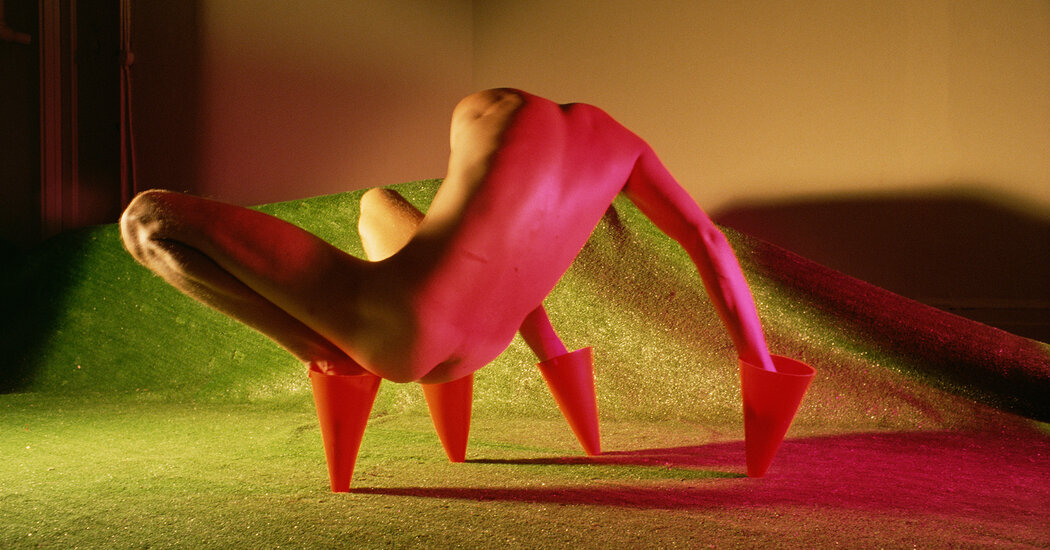A list of things Jimmy DeSana photographed — shoes, sofas, legs and butts — misses his true subject, which was a sensibility. He regarded the body as a playground, gender as an ongoing invention, and domestic interiors as surreal constructions. He had a queer take on life.
A familiar presence on the downtown New York scene, DeSana has been largely overlooked since his death in 1990, at 40, of AIDS-related illnesses. Aiming to rectify that, “Submission,” opening Nov. 11 at the Brooklyn Museum, is the first solo museum exhibition of his photographs. A show at PPOW gallery in Manhattan will follow in February.
His waggish vision — turning things upside down and inside out to revel in their strangeness — feels very current. “Speaking with so many artists of the period, DeSana was someone brought up again and again, but he was an artist who really hadn’t had any major scholarship written about their work,” said Drew Sawyer, curator of photography at the Brooklyn Museum. Conducting biographical research, Sawyer unearthed details about DeSana’s background and explored how he moved between scenes that are often considered separately: No Wave music, performance art, queer subcultures, downtown nightlife, the Pictures Generation and mail art.
“Because Jimmy was really shy, he acted like he was in on some joke,” said Laurie Simmons, the artist and filmmaker, who was one of his closest friends, his frequent model and the executor of his estate. “He was very Warholian in certain ways. He knew the combination of being shy and mysterious would work well for him. He could have a twinkle in his eye and say less. He would make some people uncomfortable. ”
Growing up in suburban Atlanta and graduating from Georgia State University in downtown Atlanta in 1972, DeSana came early to both his vocation of photography and his awareness of his sexual orientation. For his senior thesis project, “101 Nudes” (a play on the Disney movie title, “101 Dalmatians”), he photographed friends, most of them gay, posing in harshly lit suburban settings. From the photos he produced a portfolio of 56 black-and-white lithographs that depict naked people seated at the piano, sprawled on a sofa, standing by a staircase, or walking through a backyard.
Their nudity was risible, not erotic. Flouting the proprieties that stifled individuality, he introduced into decorous milieus what was inadmissible — the naked body — and used humor to punch holes in the American dream of the late-20th century. “People were just starting to make work about that suburban life,” said Simmons, who, along with Cindy Sherman and Eric Fischl, shared his interest in excavating the fault lines — sexual, political, gendered — that lay beneath the placid surface. “We had the sense of getting out and escaping.”
The Brooklyn show takes its title from a book of photos that DeSana, who moved to New York as soon as he graduated from college, published in 1980 of sadomasochistic rituals, which intrigued him at this early stage of his career. Unlike his better-known contemporary Robert Mapplethorpe, whose documentation of S&M was ceremonial and solemn, DeSana brought out the absurdity of sexual role play: a man masturbating next to a snarling little dog, or a woman in leathers and roped wrists and legs inside an open refrigerator that is empty but for a dozen eggs. From the vantage point of the gay S&M sex clubs in the Far West Village at the time, Mapplethorpe was channeling the hypermasculine, deadly earnest Mineshaft, while DeSana plugged into the rollicking hilarity of the Anvil, with its go-go boys and drag queens. The “Submission” series is shown in a room dimly illuminated with a red safelight, recalling both the darkrooms in which DeSana worked and the back rooms of the S&M sex clubs where he played.
It’s hard to demarcate between his play and work. In the exhibition, vitrines filled with East Village publications and fliers, and videos rocking with No Wave bands, evoke the texture of the period. As a street photographer doing commercial assignments for zines with occasional record-album commissions, DeSana shot the musicians who habituated late-night clubs and bars: Talking Heads, James Chance, Laurie Anderson, Debbie Harry, Richard Hell, Billy Idol and many more. Commercial gigs supported him while he made the studio photographs that constituted his art. Photography also smoothed his way socially. “He wore his camera all the time,” Simmons said. “The camera for a shy man was a great way to be out..”
DeSana embraced correspondence art, in which artists (Ray Johnson was a key figure) sent out their work in chain letters. He used the mail to distribute “101 Nudes,” as well as a discombobulating self-portrait in which he posed, naked and sexually aroused, with a noose around his neck. Perhaps DeSana knew of a famous 1840 self-portrait by Hippolyte Bayard, a pioneer of photography, who posed as a barechested drowned man. But while Bayard’s picture was merely self-pitying (he was bemoaning his lack of recognition), DeSana’s self-portrait pushed to link two subjects that were unmentionable in polite society — sex and death. He began mailing it to his correspondence-art network in 1973. The next year, General Idea, a collective of three Canadian artists, featured it on the cover of a magazine patterned on Life.
Immediately after “Submission,” DeSana started on a new series, “Suburban,” which continued his exploration of domestic settings decorated with undressed people, this time in color. He used the tungsten lights and color gels of cinematographers, but instead of gels that simulate natural illumination, he favored pastels that cast a lurid glow. He was embracing surrealism, shooting bodies from odd angles to disorient a viewer. As one of his recurring setups, he visually converted humans into quadrupeds by putting shoes on hands as well as feet. “Marker Cones,” 1982, one of his most compelling images, portrays from behind a naked man who is twisting his pink-lit body, hands and feet within inverted orange plastic cones on an AstroTurf carpet.
He was extending the legacy of the Surrealist photographers of the period between the World Wars. Man Ray in particular presented his subjects with a disorienting spin: He inverted the head of a female smoker whose cigarette looks like a chimney, cast dark shadows to make the naked torso of a woman with upheld arms resemble the head of a bull, and shot his lover, the photographer Lee Miller, from an extreme lower angle so that her neck and chin take on a phallic form. He mixed genders, even species, with gleeful abandon. DeSana joined in the game.
But a 1984 DeSana self-portrait pointed to the painful direction his life was about to take. He photographed himself in red Calvin Klein briefs illuminated in a red glow, one hand on his forehead, his eyes upturned and his expression concerned. A bright beam of white light is directed toward two dozen surgical stitches running from his sternum down his left side. His spleen had just been removed, an early warning of H.I.V. infection. The diagnosis of AIDS came a year later.
As he weakened, he changed his practice from strenuous studio performances to abstractions, still lifes and collages of flowers and body parts. He was receiving more commercial recognition. In his first show in February 1987 at the Pat Hearn Gallery in the East Village, and in a second show there the following year that included large Cibachrome prints, he seemed to be memorializing objects he loved in the world that he knew he was fated to leave prematurely. He told Simmons that he was thinking about death and nothingness. “The work he made after he was diagnosed was reaching toward the spiritual and questioning death,” she said. “He became obsessed with producing as much as he could. He told me that he wasn’t afraid, but I believe that he was.”
Simmons said that the insouciance of the photographs should not fool you. “His ambition was fierce,” she said. But the images, despite being beautifully lit and composed, float by without any sense of exertion. What is so refreshing about DeSana, in his work and apparently also in his life, is how he made everything seem like a fleeting glimpse, a momentary epiphany, a passing fancy. It was fabulous for an instant. It was fun. And then it was gone.
Sumber: www.nytimes.com












